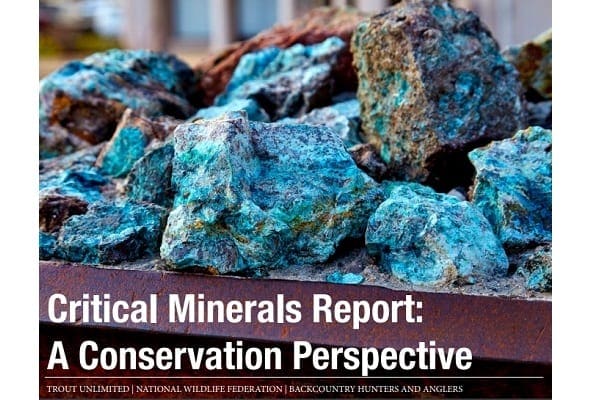New Report Explores Conservation and Critical Minerals

Coalition seeks to balance fish and wildlife conservation with mining and supply chain security
Washington D.C. (August 24, 2020) – A diverse coalition, including Trout Unlimited, National Wildlife Federation and Backcountry Hunters & Anglers, has launched its Critical Minerals Report: A Conservation Perspective exploring the confluence of fish and wildlife conservation, hunting and fishing traditions, clean energy and responsible mining.
Produced with input from angling and hunting conservation organizations, mining partners and renewable energy interests, this report identifies steps to successfully protect important fish and wildlife habitats and offers tenets for responsible mining that urge stakeholder involvement through every step of the process. The report is endorsed by XX hunting and fishing organizations and brands.
Critical minerals are those defined by Executive Order 13817 as non-fuel minerals essential to the economic and national security of the nation, the supply chains of which are vulnerable to disruption. Many of these minerals are indeed critical for high-tech industries, renewable energy production and storage, electric vehicles and military applications. Of the known critical mineral deposits, half are within coldwater trout and salmon habitat, 55 occur within priority big game winter range and migration corridors and one in 10 are in protected public lands, such as wilderness areas and inventoried roadless areas. That leaves half of the deposits as potential opportunities to responsibly access critical mineral resources. Along with responsible development where and how it can be done safely, other strategies include developing alternative technologies and emphasizing recycling to reduce demand for new mines.
“America must have a comprehensive strategy for securing the raw materials necessary for clean energy technologies that help mitigate the effects of climate change on fish and wildlife. We believe with collaboration and thoughtful policy this can be done successfully. When new mines are necessary, they must be developed responsibly and in the right locations,” said Ty Churchwell, mining coordinator for TU’s Angler Conservation Program. “We are committed to conserving trout and salmon fisheries and public lands for the next generation and urge holistic strategies for securing these resources while mitigating supply chain disruption concerns.”
“We must extract and process critical minerals responsibly. This includes avoiding certain areas and mitigating impacts to fish and wildlife habitat where extraction does occur,” said David Willms, senior director of western wildlife for the National Wildlife Federation. “Equally important, we should invest in innovation that reduces demand for critical minerals, including material alternatives, and engineering advancements.”
“Now more than ever, our natural resources demand our collective stewardship,” said John Gale, Backcountry Hunters & Anglers conservation director. We have a shared duty to our public lands and waters to ensure that development of critical minerals is balanced so that clean water, fish and wildlife habitat, and the future of our outdoor traditions aren’t compromised at the expense of addressing supply chain issues that require strategic solutions. The policy guidance proposed within these tenets for responsible development of critical minerals is a roadmap that not only will facilitate science-based resource management as new mining projects are considered, but also establishes transparency and prioritizes high standards for avoiding sensitive habitats, mitigating impacts and reclaiming project sites.”
To complement the report, Trout Unlimited has created a GIS spatial mapping tool overlaying fish and wildlife habitat, protected public lands, mining-impacted watersheds and known critical mineral deposits. This tool will help Trout Unlimited, partners and decision-makers pinpoint conflict areas and identify opportunities to avoid high-value habitats and protected public lands.
“I refuse to believe we must choose between our national security, the environment, and the economy,” said Senator Joe Manchin III, ranking member Energy Natural Resources Committee. “Reducing our import reliance of critical minerals can and should be done without sacrificing our outdoor heritage. I thank Trout Unlimited, Backcountry Hunters & Anglers, and the National Wildlife Federation for putting forth a roadmap for responsible domestic sourcing of critical minerals.”
The report emphasizes the need to avoid and minimize the impacts of mining critical minerals, outlining twelve tenets that can help facilitate responsible mining practices.
“Kinross applauds Trout Unlimited and partners’ recognition of the need for domestic sources of critical minerals and their support for responsible mining to develop these essential resources,” said Kinross Gold U.S.A., Inc.
About Trout Unlimited:
Trout Unlimited is the nation’s oldest and largest coldwater fisheries conservation organization dedicated to conserving, protecting and restoring North America’s trout and salmon and their watersheds. Follow Trout Unlimited on Facebook, Twitter, Instagram and on our blog for all the latest information on trout and salmon conservation.
About Backcountry Hunters & Anglers:
Backcountry Hunters & Anglers is the voice for our wild public lands, waters and wildlife. Learn more about Backcountry Hunters & Anglers via Facebook, Twitter, Instagram or YouTube. Visit www.backcountryhunters.org.
About National Wildlife Federation:
The National Wildlife Federation is America’s largest conservation organization with over 6 million members and 53 state affiliates. Formed in 1936, the organization strives to increase America’s fish and wildlife populations and enhance their capacity to thrive in a rapidly changing world. National Wildlife Federation works to protect, restore and connect wildlife habitat, inspire the next generation of conservationists, and advocate for policy changes necessary to save thousands of at-risk species. Learn more at Twitter @ourpubliclands and @NWF and on Facebook ourpubliclands and NationalWildlife.
